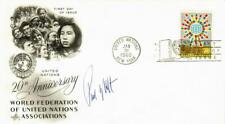Up for sale the "Marshall Plan" Paul G Hoffman Hand Signed First Day Cover Dated 1966.
ES-0913
Paul
Gray Hoffman (April 26, 1891 – October 8, 1974)
was an American automobile company executive, statesman, and global
development aid administrator. He was the first administrator of the Economic
Cooperation Administration, where he led the implementation of
the Marshall Plan from 1948–1950. Hoffman
was born in Western Springs, Illinois,
a suburb of Chicago. He quit his studies at the University of Chicago at
18 to sell Studebaker cars in Los Angeles, had
made his first million dollars by the age of 34, and became president of
Studebaker ten years later. Hoffman and Harold Sines Vance were
the two executives most responsible for rescuing Studebaker from insolvency in
the 1930s. From 1935 to 1948, Hoffman served as president
of Studebaker. From 1950 to 1953, he also served as the president of the Ford Foundation. Returning to Studebaker in 1953, Hoffman was
chairman of the corporation during the turbulent period leading up to and
during the 1954 merger with the Packard Motor Car Company.
When Studebaker-Packard found itself nearing insolvency in 1956, the company
entered into an Eisenhower agreement with Curtiss-Wright. Hoffman, Vance (who had become chairman of the
executive committee after the Packard merger) and S-P president James J. Nance all left the company. From 1966 to 1972,
he was the first administrator of the United Nations
Development Programme when it was founded, with David Owen as
his co-administrator. On June 21, 1974, he was awarded
the Presidential Medal of Freedom by
President Richard Nixon. President Harry S. Truman nominated Hoffman to
lead the Economic Cooperation Administration (ECA) in April 1948. Truman
initially wanted to nominate Dean Acheson, but Hoffman was a more acceptable candidate to
Congress, which preferred someone with more business acumen.[4] In this role as administrator, he was
responsible for managing the distribution of U.S. aid to post-WWII Europe. He
primarily worked with the Organization of
European Economic Cooperation (OEEC) and coordinated policy
with the U.S. State Department. He
was a forceful advocate of European integration. In
September 1949, Hoffman and his staff met in Washington to assess the progress
of the Marshall Plan. They agreed that the "salvage function is
substantially completed" and that the ECA should now focus on integrating
the economies of Europe by supporting European-led initiatives to reduce trade
barriers, coordinate fiscal policy, streamline regulation, and ensure currency
convertibility and stability. This would, in their view, strengthen the
European economies so that by they could be "free from dependence on
sustained outside assistance." His most famous speech as
ECA administrator was his October 31, 1949 address to the OEEC in which he
argued that Europe must integrate. Invoking a comparison to the United States,
he argued: The substance of such integration would be the formation of a single
large market within which quantitative restriction on the movements of goods,
monetary barriers to the flow of payments and, eventually, all tariffs are
permanently swept away. The fact that we have in the United States a single
market of 156 million consumers has been indispensable to the strength and
efficiency of our economy. The creation of a permanent, freely trading area,
comprising 270 million consumers in Western Europe would have a multitude of
helpful consequences. It would accelerate the development of large-scale,
low-cost production industries. It would make the effective use of all
resources easier, the stifling of healthy competition more difficult... This is
why integration is not just an ideal. It is a practical necessity. He
concluded this speech with a veiled threat that the U.S. Congress may not
continue to fund the Marshall Plan if the Europeans did not integrate.
Congressional leadership was, indeed, skeptical of continuing to fund the
Marshall Plan absent integration. Hoffman's tenure as
administrator of ECA was marked by dramatic improvements in the industrial and
agricultural output of countries receiving Marshall Plan aid. July
19, 1962 Hoffman married businesswoman Anna M. Rosenberg. His first wife was Dorothy Brown. They
married in 1915. She died in May 1961. She was a Christian Scientist. The
couple had five sons, Hallock, Peter, Donald, Robert and Lathrop, and two
adopted daughters, Barbara and Kiriki.

Related Items:

Information on the Marshall Plan for Americans Going Abroad ECA booklet 1950
$12.00

"Marshall Plan" Paul G Hoffman Hand Signed FDC Dated 1966
$149.99

1950 BOOKLET: INFORMATION ON THE MARSHALL PLAN FOR AMERICANS GOING ABROAD: '49:
$20.00